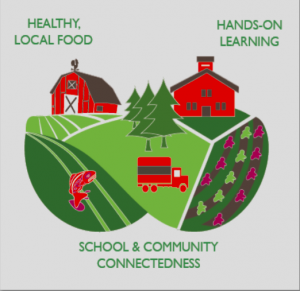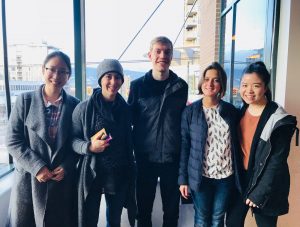<The Beginning>
About Farm-to-School BC:
Farm to School (F2S) is an international movement, aiming to bring healthy, local food into schools, and provide students with hands-on learning opportunities that foster food literacy, all while strengthening local food systems and enhancing school and community connectedness. F2SBC is a provincial umbrella organization with 3 regional hubs, including a “Vancouver Area” regional hub.

Group Interests:
We are interested in a variety of plants, Indigenous way of life/learning, and interacting with children. We see Indigenous plants as assets being part of a greater foodscape composed of food plants, teaching plants, medicinal plants, plants used for ceremony and celebration, and plants used as materials.
Reasons/Goals for Choosing this Project:
- To learn more about Farm-to-School program from this experience, including how the process of Farm-to-School works and how it influences students, teachers, and farmers.
- To gain some knowledge about Indigenous plants
- To learn what we can do about indigenous uses for native plants by Lori Snyder, an expert in the field.
What are we doing:

We are working with the Vancouver regional hub of Farm to School BC (F2SBC) at the school food system level. We will be joining indigenous plant expert Lori Snyder as she meets with school administrators and teachers to discuss the goals of each respective school, determine their current native plant assets at each schoolyard, and decide what needs to be added or repaired in order to create an indigenous foodscape and foster a positive learning environment for students. We will document the discussions and decisions and identify any infrastructure gaps and required materials along with other biophysical and logistical data. We will then synthesize the text, data, and media from our tours to develop a concise multimedia report for each of the two schools we will be visiting. The reports will be given to Samantha Gambling who will review the information and share with the funders, the schools, and the public at large. Our two reports will be compiled with those from other groups for Samantha to compare the school’s current and required infrastructure to determine the allocation of future funding so the schools are able to meet their goals.
First Impressions and New Ideas:
As a group, we are interested in medicinal indigenous plants, First Nations’ ways of life and interacting with children, which were our motivations for choosing this project. However, we were unpleasantly surprised at the meeting with Sam and Lori when we realized that none of those things would actually be included as part of the project. Instead, the project seemed very administrative and not nearly as hands-on as it was advertised.
Having said that, Sam and Lori seem like wonderful community partners to work with. We have been promised a native plant tour at UBC by Lori Snyder as a thank you for our work which should be very rewarding and is the piece of the project we are more excited about.
In terms of Sirolli’s insights on community development, we do not find it very applicable to our project. In some sense, we are working with the teachers and listening to what they envision in their garden (instead of imposing a uniform model for every school) so that is a valuable piece. On the other hand, we are having trouble seeing our value in this project since our skills and interests are not being taken into account. We are there to record information – any computer could do that. In order to ameliorate this disappointment we propose an idea to enhance our project experience:
Integrating our readings from the Principles of Asset-Based Community Development and Food Justice, we have assessed an opportunity for enhancing social assets in the F2SBC and UBC LFS partnership by bridging a gap between two needs:
- As was mentioned in our first Vancouver School Board meeting, many teachers involved in this project are not yet sure how they will integrate these community gardens into their learning curriculums.
- It was the feeling from our group that our collective skills and knowledge were not being fully utilized for this project (under-utilized social capital).
In order to meet the demand that VSB teachers have for creative food system teaching tools, we propose creating an open forum “knowledge bank” where students can contribute interesting facts they are learning in their courses to do with Land and Food Systems. In this way, LFS students have the opportunity to feel like their unique and individual social capital (knowledge) is being more fully utilized, while teachers will gain a diverse and interesting resource to help inspire curriculum integration.
This open forum “knowledge bank” could be accessible to all LFS students involved in this particular community project and it could be open for the duration of the time we work with the VSB. Over time, if it is successful, we may see an aggregation of ideas into categories. If there are enough categories we may be able to make a final Prezi document to help visualize these ideas and their interconnectedness in an easy to understand format for teachers (and possibly students). It would be a good idea to have a reference for each fact (and possibly a reference to the course and teacher taught at UBC). If the F2SBC project is highly successful and inspiring to future post-secondary students, we may be able to anticipate an increased interest in the LFS program at UBC among high school students. A document such as this may help them navigate and visualize a degree within LFS, if they choose to pursue one.
So…
Follow us on our journey, and learn WITH us about the Indigenous Foodscapes and how native gardens were and/or will be grown in Vancouver schools!
ps: If you are interested in who we are, please check out About us page!